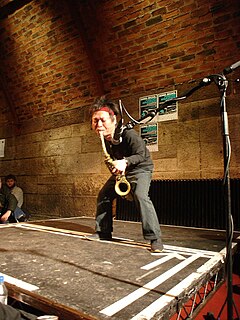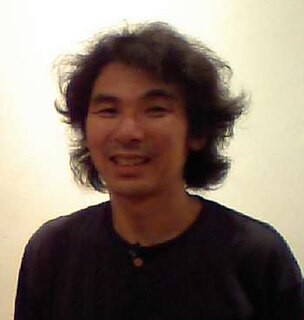Related Research Articles

Gamelan is the traditional ensemble music of the Javanese, Sundanese, and Balinese peoples of Indonesia, made up predominantly of percussive instruments. The most common instruments used are metallophones played by mallets and a set of hand-played drums called kendhang which register the beat. The kemanak and gangsa are commonly used gamelan instruments in Java. Other instruments include xylophones, bamboo flutes, a bowed instrument called a rebab, siter, and even vocalists named sindhen (Female) or Gerong (Male).
The United Kingdom was represented in the Eurovision Song Contest 1982 by Bardo with the song "One Step Further". It was chosen as the British entry through the A Song for Europe national selection process and placed seventh at Eurovision, receiving 76 points.
Farrah Laron Franklin is an American singer-songwriter and actress. She is a former member of Destiny's Child who, along with Michelle Williams, replaced LaTavia Roberson and LeToya Luckett.

Fahd Azam, known professionally as Mr. Capone-E, is a Pakistani-American rapper and record executive. He is the owner of Hi-Power Entertainment.
The Taj Mahal Travellers were a Japanese experimental music ensemble founded in 1969 by former Group Ongaku leader and Fluxus member Takehisa Kosugi. The rest of the group were several years younger than Kosugi, and were all inspired by the spirit of the day. They chose mainly to perform their music outdoors, often on beaches and hilltops, creating spontaneously improvised drones, often using standard musical instruments, albeit in unconventional ways. The group's sound was heavily reliant on electronic processing, particularly delay effects.

John Bruce Wallace is an American composer and avant-garde, free jazz, fusion, experimental, improvisational progressive metal guitarist.
Takehisa Kosugi was a Japanese composer, violinist and artist associated with the Fluxus movement.

Masaaki Endoh is a Japanese singer-songwriter who is prominent in the area of soundtracks for anime and tokusatsu productions. He is one of the founders of the Anison band JAM Project and has been a regular member ever since its inception in 2000. His nickname is the "Young Lion of Anison" and he goes by the motto "Always Full Voice".

Masayoshi Urabe is a Japanese musician, best known for his intensely physical style of free improvisation on the alto saxophone and his deployment of long, laden silences. He has sometimes been compared to the late Japanese free jazz altoist Kaoru Abe.
He has played with many underground musicians in Japan, including Chie Mukai (Ché-SHIZU), Kan Mikami (Sanjah), Hiroshi Hasegawa, Junko (Hijokaidan) and the psychedelic rock group Kousokuya. Recently he formed the group Sanjah, with folk singer Kan Mikami and drummer Toshi Ishizuka. He also performs with the Paris-based dancer Yukiko Nakamura.
Ché-SHIZU and others. The group's sound is dominated by Mukai's vocals and er-hu playing. The group was formed in 1980. Many notable musicians from the Japanese underground have played in the group at one time or another, including Tori Kudo, Masami Tada, Masami Shinoda, Yuriko Mukojima, and Ikuro Takahashi.
Chie Mukai is a female Japanese composer and musician, best known for her underground improv-folk group Ché-SHIZU. She has been involved in improvised performance since 1975, when she participated in the East Bionic Symphonia group, a graduation project for students of Takehisa Kosugi at the Bigakko art school in Tokyo. Her primary instrument is the bowed Chinese er-hu, although she is also a vocalist, and plays piano and percussion. Every year she organizes the Perspective Emotion mixed media arts festival in Tokyo. She has been frequently collaborating with Kenya Kawaguchi, Masayoshi Urabe, Seiichi Yamamoto since 2010.
Marginal Consort is a Japanese collective/free improvisation group made of sound and visual artists, who have played one concert annually since 1997. The group originally grew out of the East Bionic Symphonia, who recorded one album in 1976. The members are Kazuo Imai (今井和雄), Yasushi Ozawa (小沢靖), Tomonao Koshikawa (越川知尚), Kei Shii (椎啓), and Masami Tada (多田正美). Chie Mukai participated in the first two concerts, but no longer plays with the group.
Kazuo Imai is a Tokyo-based guitarist who plays in a rigorous and original free improvisation idiom. His music joins the rigour and texture of contemporary classical with the passion of free jazz. He has played with many Western and Japanese improvisers, including Lee Konitz, Barre Phillips, Arthur Doyle, Han Bennink, Irene Schweizer, Shuichi Chino, Tetsu Saitoh and Kazue Sawai. In addition to playing solo and in collaborations, Imai is also a member of the important collective improvisation group Marginal Consort. As well as guitar, Imai also plays viola da gamba.
Yasushi Ozawa (1958–2008) was a Japanese musician and sound engineer, best known as the bassist in Keiji Haino's rock group Fushitsusha. He was also a member of the free improvisation group Marginal Consort, and in the past he played with East Bionic Symphonia and Machine-Gun Tango.
Tres Coronas, was a group of 3 MCs, born in early 2001 in Queens, New York composed of the New Yorkers/Colombian Luis Alfonso Fonseca known as PoNchO or P.N.O a.k.a. Guajiro, the French/Colombian Sébastian Rocca known as Rocca a.k.a. El Chief, and the Dominican José Alberto Collado known as Reychesta a.k.a. Secret Weapon. Their music deals with issues of everyday life. Their best-known songs are off their albums Red Mixtape and Nuestra Cosa. Some of their hit tracks are "Falsedades", "Envidias", "Ahora O Nunca". Different producers such as Artwell Smart, Gallegos, Chaze, Shakim and others worked on their albums and projects.
The Hager Twins, also known as the Hager Brothers and The Hagers, were a duo of American country music singers and comedians who first gained fame on the TV series Hee Haw. They were identical twin brothers James Henry Hager and John William Hager.
Izumi Kimura is a Japanese pianist and teacher now living in Ireland. Kimura currently teaches at the Dublin City University in jazz and contemporary music studies. As a performer and composer, she has been associated with contemporary music and is perhaps best known for her 2010 début album Asymmetry.

Ayuo Takahashi is a Japanese-American composer, poet, lyricist, singer and performer of plucked string instruments including guitar, bouzouki, Irish harp, Chinese zheng, Japanese koto, and medieval European psaltery. He is adept at adapting the ancient music of Japan, China, Persia, Greece and medieval Europe to create a new and original music without abandoning their strict forms, while simultaneously making them relevant to contemporary music styles. He has composed for classical ensembles including string quartets, piano, various chamber ensembles and orchestra, as well as composed, produced and performed with rock, jazz and musicians of various traditional music from around the world. He has also composed many music theater pieces, some of which has been released on CD in the United States and Japan.

Pavel Karmanov is a composer and a Russian rock musician.
Raga Gara is a Hindustani classical raga belonging to the Khamaj Thaat. This raga is similar to raga Jaijaiwanti. Both ragas have the same svaras. Gara is a rare raga. It is rendered in the late evening. The raga uses all the seven notes, six in the ascent and seven in the descent. Therefore the Jati of the raga is Shaadav-Sampurna. While some say that seven svaras are played in the ascent and seven in the descent. Therefore the Jati then becomes Sampurna-Sampurna. It uses both, the Komal (flat) and Shuddha (full) Nishad, and all other notes are Shuddha (full). The derivative ragas out of this structure are grouped under the broad head of Khamaj Thaat. Gara belongs to a family of melodic entities, which were apparently derived from folk melodies, and entered art-music in association with the thumri genre. This family includes ragas like Kafi, Piloo, Jangula, Barwa, and Zilla, along with several others. This raga expresses the feeling of happiness and satisfaction of achievement, however it simultaneously conveys the sadness of losing. This raga is also a vivacious and romantic one.
References
Interview with Chie Mukai. G-Modern, issue 14, Winter 96-97. pp. 11–23 (Japanese)
Stofer, F. (2000). Japanese Independent Music, France: Sonore. ISBN 2-9515644-0-6